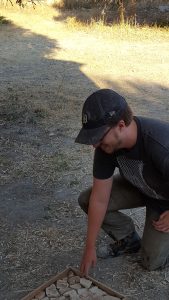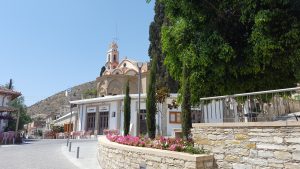
CHANGING PERSPECTIVES ON CYPRUS
Andrew Crocker, 2017 Platt Fellowship Recipient
Thanks to the generosity of the Platt Fellowship, ASOR, and all of the donors to ASOR’s various fellowships, I was able to travel to Cyprus and excavate in the area about which I wrote my Master’s thesis. I participated in the Kalavasos and Maroni Built Environments (KAMBE, http://classics.cornell.edu/kambe) project in the Vasilikos and Maroni valleys on the south coast of Cyprus. At KAMBE I was able to work on a wide array of activities. I built photogrammetric models of several excavated features, assisted with mapping at site, participated in excavation, pottery washing, and briefly helped prepare samples for the dendrochronological component of the project. At KAMBE, all of these projects and more come together in an effort to understand the constructed areas together with the environment of southern Cyprus in the Late Bronze Age through several case studies.
The project’s focus on the large scale built and natural environments of the valleys resonated with me, especially due to my Master’s thesis work on the spatial patterning of artifacts in the Maroni valley and the different approaches taken at KAMBE to record and understand the materials excavated. Before coming to KAMBE, my main experiences with the Maroni and Vasilikos valleys and their artifacts were through reading published reports and mapping finds on my computer, far from Cyprus. When I came to Cyprus and experienced the valleys personally, I had an extremely different perception of the same places that I had spent so long looking at and studying from afar. My perceptions of the valleys continued to change, with new aspects catching my attention or being put into a different context, with each change in what I was doing at the project.
Although I knew that my mapping work before coming to Cyprus only exposed me to one aspect of the landscape of the Maroni and Vasilikos valleys, I was surprised by just how radically changed my views and thoughts were with each new approach. Through mapping, I was able to understand and communicate how parts of the ancient landscape related to each other. However, my walking through the valleys and noticing what parts the sea breeze reached and other components of the human experience that I could never access without actually setting foot on the sites. Working with and modeling individual aspects of the site, in turn, made me focus on small details of objects that can easily become unnoticed parts of the background when mapping or moving through the landscape. Of course, none of these perspectives are exclusive, and all are stronger from being considered together. Changing perspectives lead to new viewpoints and interpretations. In my view, the greatest benefit of the Platt Fellowship and ASOR’s other excavation fellowships is enabling students and researches to approach the same material from many perspectives, including excavation.
The different perspectives on the Vasilikos and Maroni valleys that I encountered also led me to think about different ways of presenting archaeological data, especially since that was the main point of the many hours I spent working on photogrammetric models. Sitting in Kalavasos and talking about the day’s work with other participants at KAMBE and visitors, as well as friends and family back home, I often thought about how difficult it can be to accurately communicate all the different aspects of an archaeological project. Maps can tell someone what is where, models can let a student or researcher examine an object in highly detailed three dimensions, and stories and pictures can communicate some of the human experience. However, all of these methods pale in comparison to traveling to a site in person and directly interacting with it together with new technologies. Thus, grants like the Platt Fellowship remain the best way to help a graduate student like me or a researcher learn about ancient landscapes.


